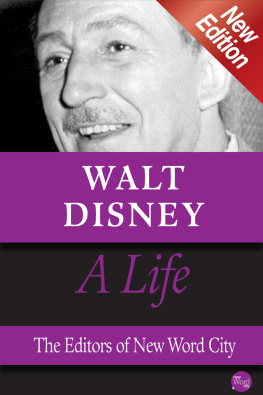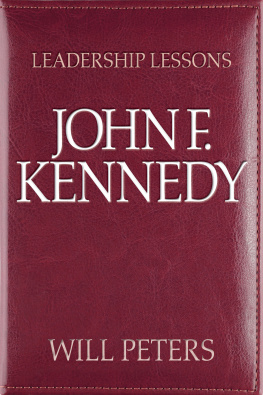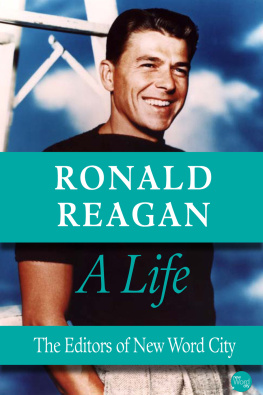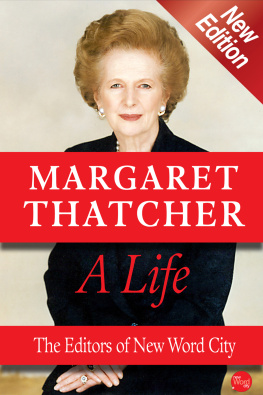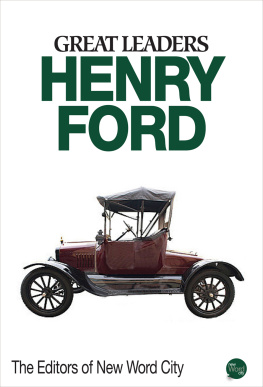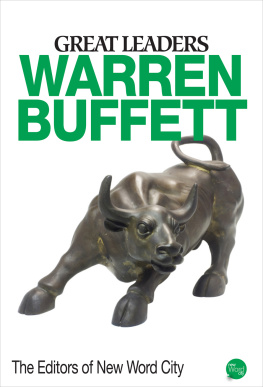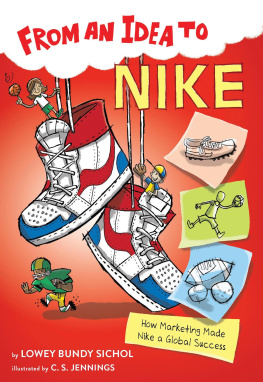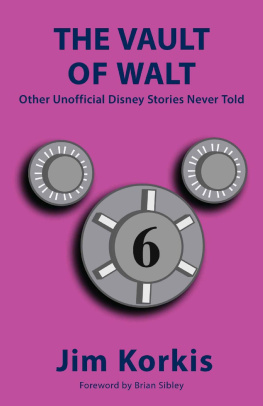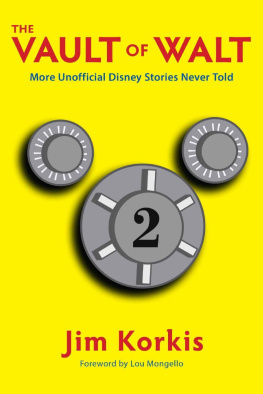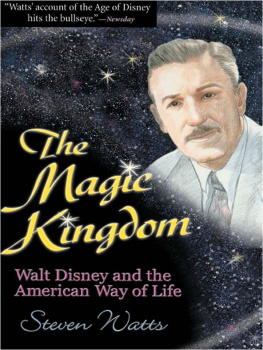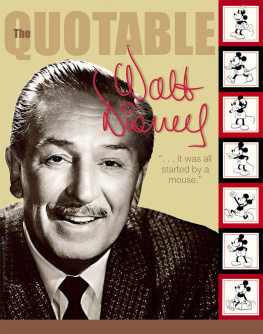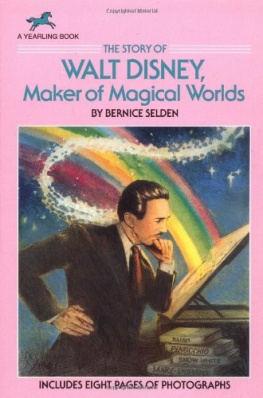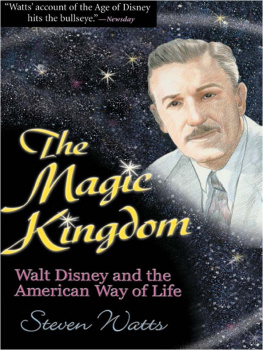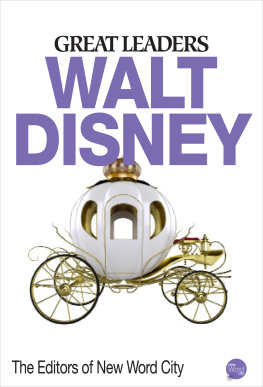WALT DISNEY, A LIFE
Walter Elias Disney assumed many roles during his relatively short life (he died of lung cancer in 1966 at the age of sixty-five): artist, animator, entrepreneur, producer, entertainer, icon, family man, and philanthropist. He spurred the imaginations and shaped the childhoods of countless millions of children around the world, and he continues to do so today. He gave us Mickey Mouse (Disney himself provided Mickeys voice in the early days), Donald Duck, Snow White, and a bevy of other beloved characters and stories. He was an innovator, embracing technology as a tool to continuously improve his products. He received more Academy Awards than anyone else in history he was the recipient of four honorary and twenty-two actual Oscars, including a record four in one year. Disney also won seven Emmy Awards, built Disneyland (which boasts more than 16 million visitors a year) and Disney World (which opened after his death and receives in excess of 47 million visitors annually). The Walt Disney Company, which he founded with his brother Roy, grosses more than $40 billion a year.
But all was not happy endings and cartoon bluebirds in the Magic Kingdom. As is so often the case, genius is a complex equation, and there were shadows to Disneys carefully honed, folksy persona. He was notoriously tough on his employees, anti-union, and sometimes an arbitrary, hot-tempered, micro-managing boss.
There have been accusations, some of them proven, of far worse sins than being a tough taskmaster. Chief among them - confirmed by The New York Times after examining Disneys Federal Bureau of Investigation file: In 1940, he became an undercover spy for the FBI, charged with ferreting out communists in Hollywood. In the file, the names of those he gave to the House Un-American Activities Committee were blacked out, but this was an ugly time - gifted artists saw their careers derailed and even destroyed because of their political beliefs - and Disney was part of it. He was also accused of being anti-Semitic. In 1938, he welcomed German filmmaker and Nazi propagandist Leni Riefenstahl to Hollywood. During that same decade, he went to Europe and met with Nazi and Fascist leaders, including Benito Mussolini, but most observers believe those meetings were an attempt to retain his toehold in the European market.
So this remarkable man, who brought so much joy into the world, also had an unsavory side. That might shock the children frolicking at one of his amusement parks, but it should come as no surprise to adults. When someone is as talented, driven, and successful as Walt Disney, there are usually complications. As he himself put it, I always like to look on the optimistic side of life, but I am realistic enough to know that life is a complex matter.
And thats just what makes Walt Disneys story so compelling.
Opening Credits
Walt Disney came into the world on December 5, 1901, in Chicago, in the bedroom of a modest house his father had built. He had three older brothers; a sister, Ruth, came along two years later. His parents, Elias and Flora Disney, were of Irish-Canadian and German descent respectively, although the name Disney has French origins - a distant ancestor named Robert dIsigny came to Ireland from France with William the Conqueror in 1066; Disney is an Anglicized version of dIsigny. Walts father, who had an erratic employment history, moved the family to a farm in Marceline, Missouri, in 1906. It was there that Disneys artistic talent first asserted itself - and earned him some money. A retired doctor who lived nearby spotted Walts drawing talent and paid him to create a portrait of his horse Rupert. It was also in rural Missouri that he developed a passion for trains, ignited by the Atchison, Topeka and Santa Fe line that ran through town; he would put his ear to the tracks to listen for approaching locomotives.
In 1911, the Disneys moved to Kansas City, where Walt and his younger sister Ruth attended the public Benton Grammar School. A classmate who came from a family of entertainment buffs introduced Walt to the world of vaudeville and motion pictures, which had only recently gone from being viewed on individual Nickelodeon machines to being projected onto screens in theaters. Disney was fascinated by the silent movies and also by how enthralled audiences were by them. And he was hooked on the Saturday classes he took at the Kansas City Art Institute. But the greatest influence on young Walt was Electric Park, an early amusement park only fifteen blocks from his home. Walt and Ruth would visit often, dazzled and delighted. Electric Park featured meticulous landscaping that framed the rides and led visitors through the park, a train track that ringed the park, multicolored lights focused on spouting fountains, and daily fireworks at closing time.
In 1917, the family moved back to Chicago after Elias became part owner of the O-Zell jelly factory. Walt enrolled at McKinley High School - he quickly became cartoonist for the school newspaper - and took night courses at the Chicago Art Institute. World War I was raging, and sixteen-year-old Walt quit school and tried to enlist in the Army, but was rejected as underage. Determined to be part of the war effort, he joined the Red Cross and was sent to France. Armistice was signed on November 11, 1918, and Disney arrived soon thereafter and stayed a year, driving an ambulance. He may have missed the war, but he certainly contributed to the peace.
Laughing All the Way to Bankruptcy
After returning from France, Disney had no interest in going back to high school and his formal education ended. He knew what he wanted to do with his life, and it didnt include sitting in a classroom or working at a jelly factory. He moved back to Kansas City and, through his older brother Roy, found temporary work at the Pesmen-Rubin Art Studio, where he created ads for newspapers, magazines, and movie theaters. It was here that he befriended fellow cartoonist Ubbe Iwerks, who would come to play a large role in Disneys success. The two decided to start their own business.
And so in January 1920, at the tender age of eighteen, Disney and Iwerks formed Iwerks-Disney Commercial Artists. The orders didnt surge in, and Disney was forced to take a job at the Kansas City Film Ad Company, where he was soon joined by Iwerks. Their own company limped to its demise, which was great for Disney and the world, because it was at the Kansas City Film Ad Company that - while making crude animated commercials using cutouts - he fell in love with the process and potential of animation. He resolved to become an animator, and the owner of the company lent him a camera to experiment with at home. An obsession took hold - Disney read everything he could find on the subject and became convinced that celluloid (the material the images were drawn on) animation would produce far better results than cutouts.
In May 1922, Disney opened his own animation studio called Laugh-O-Gram Films - capitalized with $15,000 - and hired Iwerks and other gifted pioneers of the animation arts. The company quickly got a contract with a local theater owner to produce six cartoons based on popular fairy tales, including Little Red Riding Hood, Jack and the Beanstalk, and Goldilocks and the Three Bears. In those days, going to the movies was a distinctly different experience than it is today. The phenomenal success of the young medium had led to the construction of ornate movie palaces designed to lure people in with a taste of elegance and the exotic, and most showed double and even triple features. Between films were cartoons and newsreels. Times were flush for the film business: It had few competitors and millions of customers who couldnt get enough of smoldering stars and funny cartoons.

